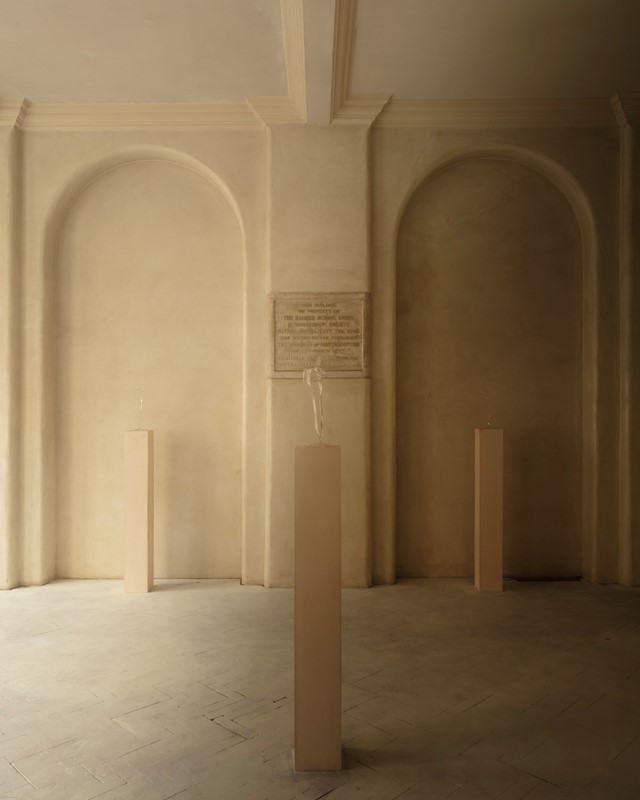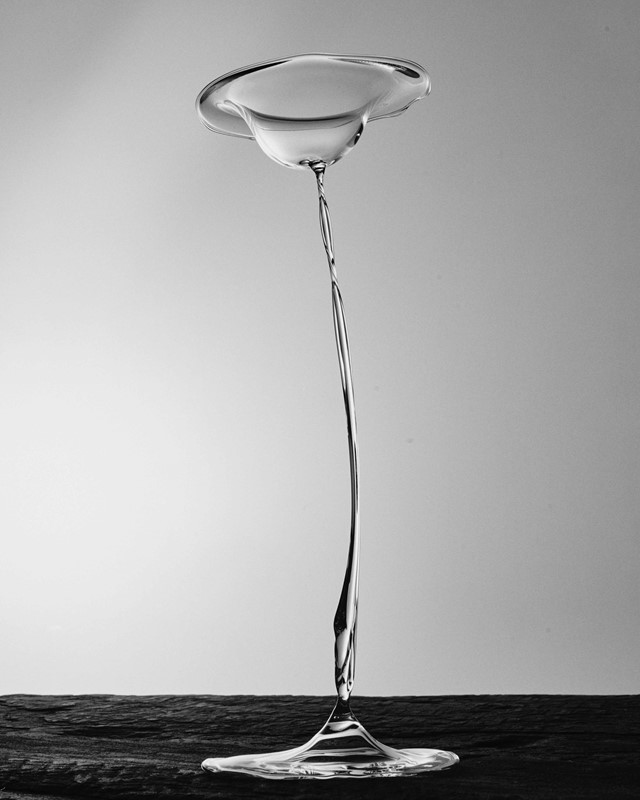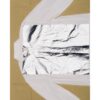
Rewrite
As the artist and maker’s new exhibition opens at the Ragged School in Southwark, Milly Burroughs talks to her about her idiosyncratic way of working
With an ethereal breathiness as endearing as the untamed choreography of her abstracted glass objects, artist and maker Miranda Keyes credits the unearthly aura of her debut solo exhibition Tulips to its historic location and the unbridled trust of curator and cult tastemaker Jermaine Gallacher.
More than seven years since the pair first met in an abandoned waterworks on a tiny island in the middle of the River Thames, Gallacher and Keyes have found a new architectural poetry within which to present the artist’s latest body of work among the waxed gypsum plaster walls and high ceilings of Southwark’s Ragged School.
With a strict embargo on the use of tactile installation techniques such as nails and screws, and the ominous presence of a deeply carved stone plaque that speaks physically of the age and fragility of the building, Keyes describes finding herself working in collaboration with the space itself as she brought the the show to life, revisiting previously shunned methods of displaying her work with a reframed perspective.
“It’s a very specific space that we’re working with, so the objects have been made very much in dialogue with it – and I’ve never really worked that way before,” she explains. “It’s been quite moving in a way, and a really generative experience.”
Describing the texture-rich walls and ceiling, she continues, “There’s this incredible sheen and depth in the almost pale pink of this very special place, but then you can’t drill into the walls and you can’t drill into the floor. You can’t actually drill anywhere. There are a lot of limitations, but around some really interesting things which, in the end, actually sort of made the show. We cast these plaster plinths because things have to be freestanding and away from the wall, but they work really well. I’m usually hesitant to use plinths, but there’s something wonderful about the solidity of these and the way in which they interact with the space. I’d actually love it if people bought the pieces with the plinths; they are so sculptural and really beautifully suited to the works.”

Keyes first encountered glass blowing while living in Berlin, while more focused on working with bronze. Having previously described her practice as “material-led”, Tulips sees the artist living up to her reputation for harnessing the charming unpredictability of glass, while leaning into the medium’s spontaneous choreography. The exhibition comprises numerous singular freestanding sculptural objects, as well as pendulous and wall-mounted lighting pieces created in collaboration with Karum Friel.
While the name of the show and some of the sinuous forms perched on plaster plinths might evoke floral forms, Keyes is quick to affirm her commitment to the organic abstraction that is innate to glass. I hate naming things, so I just called it Tulips because I think it’s such a sexy word. Now I realise people are going to think it’s a figurative reference to the shapes, but it’s purely about the word. People read all sorts of stuff into the work, but for me, it’s about the material and the pleasure of working with something so temperamental and weird that you get completely locked into producing. Pleasure is important!”
More than a year since Keyes and Gallacher began planning the exhibition, Tulips has emerged as a testament to the synergistic relationship they have cultivated throughout the years they’ve grown to know each other. Recognised by his unapologetic curation of interiors and his own Lant Street gallery, Gallacher’s unwavering dedication to championing those whose creativity fuels his own is evident in the uncompromising sense of identity Tulips embodies, with what is ultimately a subtle, fragile and sometimes difficult to engage with medium.

Describing the creative process of working with Gallacher on the exhibition, Keyes speaks fondly. “The freedom that he afforded me has been integral to the process. He didn’t demand much, and I was able to work in a very intense way, but also in a very intuitive way; he wasn’t imposing any limitations or pressures.”
She adds, “There’s a huge amount of trust implicit when anyone does a show with you, because they’re taking a punt – and it’s not just money, it’s time too. It’s a huge investment of resources on all fronts. What underpins that is a belief in art, and a belief in the power of bringing together people and things. And I know that Jermaine really believes in those things.”
Tulips by Miranda Keyes is on show at the Ragged School, 47 Union Street, London, SE1 1SG, until November 30.
in HTML format, including tags, to make it appealing and easy to read for Japanese-speaking readers aged 20 to 40 interested in fashion. Organize the content with appropriate headings and subheadings (h1, h2, h3, h4, h5, h6), translating all text, including headings, into Japanese. Retain any existing
tags from
As the artist and maker’s new exhibition opens at the Ragged School in Southwark, Milly Burroughs talks to her about her idiosyncratic way of working
With an ethereal breathiness as endearing as the untamed choreography of her abstracted glass objects, artist and maker Miranda Keyes credits the unearthly aura of her debut solo exhibition Tulips to its historic location and the unbridled trust of curator and cult tastemaker Jermaine Gallacher.
More than seven years since the pair first met in an abandoned waterworks on a tiny island in the middle of the River Thames, Gallacher and Keyes have found a new architectural poetry within which to present the artist’s latest body of work among the waxed gypsum plaster walls and high ceilings of Southwark’s Ragged School.
With a strict embargo on the use of tactile installation techniques such as nails and screws, and the ominous presence of a deeply carved stone plaque that speaks physically of the age and fragility of the building, Keyes describes finding herself working in collaboration with the space itself as she brought the the show to life, revisiting previously shunned methods of displaying her work with a reframed perspective.
“It’s a very specific space that we’re working with, so the objects have been made very much in dialogue with it – and I’ve never really worked that way before,” she explains. “It’s been quite moving in a way, and a really generative experience.”
Describing the texture-rich walls and ceiling, she continues, “There’s this incredible sheen and depth in the almost pale pink of this very special place, but then you can’t drill into the walls and you can’t drill into the floor. You can’t actually drill anywhere. There are a lot of limitations, but around some really interesting things which, in the end, actually sort of made the show. We cast these plaster plinths because things have to be freestanding and away from the wall, but they work really well. I’m usually hesitant to use plinths, but there’s something wonderful about the solidity of these and the way in which they interact with the space. I’d actually love it if people bought the pieces with the plinths; they are so sculptural and really beautifully suited to the works.”

Keyes first encountered glass blowing while living in Berlin, while more focused on working with bronze. Having previously described her practice as “material-led”, Tulips sees the artist living up to her reputation for harnessing the charming unpredictability of glass, while leaning into the medium’s spontaneous choreography. The exhibition comprises numerous singular freestanding sculptural objects, as well as pendulous and wall-mounted lighting pieces created in collaboration with Karum Friel.
While the name of the show and some of the sinuous forms perched on plaster plinths might evoke floral forms, Keyes is quick to affirm her commitment to the organic abstraction that is innate to glass. I hate naming things, so I just called it Tulips because I think it’s such a sexy word. Now I realise people are going to think it’s a figurative reference to the shapes, but it’s purely about the word. People read all sorts of stuff into the work, but for me, it’s about the material and the pleasure of working with something so temperamental and weird that you get completely locked into producing. Pleasure is important!”
More than a year since Keyes and Gallacher began planning the exhibition, Tulips has emerged as a testament to the synergistic relationship they have cultivated throughout the years they’ve grown to know each other. Recognised by his unapologetic curation of interiors and his own Lant Street gallery, Gallacher’s unwavering dedication to championing those whose creativity fuels his own is evident in the uncompromising sense of identity Tulips embodies, with what is ultimately a subtle, fragile and sometimes difficult to engage with medium.

Describing the creative process of working with Gallacher on the exhibition, Keyes speaks fondly. “The freedom that he afforded me has been integral to the process. He didn’t demand much, and I was able to work in a very intense way, but also in a very intuitive way; he wasn’t imposing any limitations or pressures.”
She adds, “There’s a huge amount of trust implicit when anyone does a show with you, because they’re taking a punt – and it’s not just money, it’s time too. It’s a huge investment of resources on all fronts. What underpins that is a belief in art, and a belief in the power of bringing together people and things. And I know that Jermaine really believes in those things.”
Tulips by Miranda Keyes is on show at the Ragged School, 47 Union Street, London, SE1 1SG, until November 30.
and integrate them seamlessly into the new content without adding new tags. Ensure the new content is fashion-related, written entirely in Japanese, and approximately 1500 words. Conclude with a “結論” section and a well-formatted “よくある質問” section. Avoid including an introduction or a note explaining the process.


